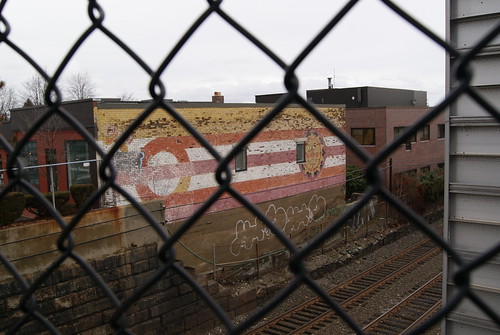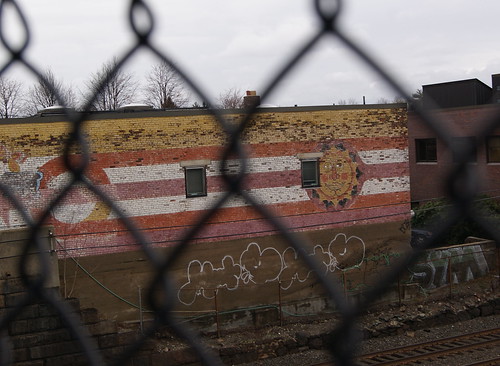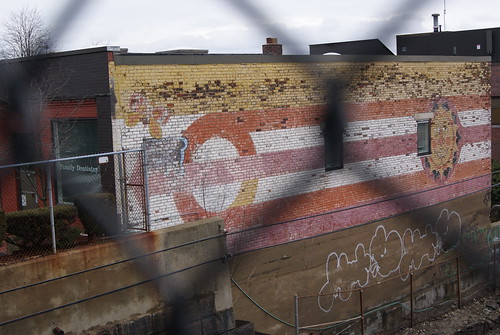Monday, December 27, 2010
Shameless Plug
From Dave Brigham:
We interrupt this blog about dilapidated buildings, abandoned vehicles and old quarries to bring you a bit of shameless self-promotion. I've published my first book, a collection of short stories called (C)rock Stories: Million-Dollar Tales of Music, Mayhem and Immaturity.
You can buy it here.
We now return you to your regularly scheduled blog.
We interrupt this blog about dilapidated buildings, abandoned vehicles and old quarries to bring you a bit of shameless self-promotion. I've published my first book, a collection of short stories called (C)rock Stories: Million-Dollar Tales of Music, Mayhem and Immaturity.
You can buy it here.
We now return you to your regularly scheduled blog.
Sunday, December 26, 2010
Where the Sun Never Sets
From Dave Brigham:
The sun never sets in Auburndale, Mass.
I pass by this mural to and from my daughter's preschool three days a week. Tens of thousands pass it every day on the Mass. Pike. Most people, if they notice it at all, have no idea the history behind it. I didn't either until I hit the "return" button on my Google search. Even still, I have more questions than answers.

According to a blog thread at the web site for the Newton Tab weekly newspaper, the mural was painted in 1969 or 1970 on the back of a "new-Agey" store called "Ends of the Earth." Evidently, according to the blog, the mural attracted local and national press because of the "hidden meaning" the painting held. Two people posted on the blog about this supposed meaning, which may or may not have been obscene, but nobody has any details.

Nowadays, it seems very innocent: a sun, what appears to be a butterfly, a circle and some long, straight lines. I'd really like to know what was on the mural in its original incarnation. I may have to buy a time machine, which would be worth it, because according to another post on the above-mentioned blog, the building used to be a restaurant and bar.

Who painted this mural? What was on it that some people deemed obscene? What products did "Ends of the Earth" sell? Why did this mural get saved in a cleaned-up version? So many questions...
The sun never sets in Auburndale, Mass.
I pass by this mural to and from my daughter's preschool three days a week. Tens of thousands pass it every day on the Mass. Pike. Most people, if they notice it at all, have no idea the history behind it. I didn't either until I hit the "return" button on my Google search. Even still, I have more questions than answers.

According to a blog thread at the web site for the Newton Tab weekly newspaper, the mural was painted in 1969 or 1970 on the back of a "new-Agey" store called "Ends of the Earth." Evidently, according to the blog, the mural attracted local and national press because of the "hidden meaning" the painting held. Two people posted on the blog about this supposed meaning, which may or may not have been obscene, but nobody has any details.

Nowadays, it seems very innocent: a sun, what appears to be a butterfly, a circle and some long, straight lines. I'd really like to know what was on the mural in its original incarnation. I may have to buy a time machine, which would be worth it, because according to another post on the above-mentioned blog, the building used to be a restaurant and bar.

Who painted this mural? What was on it that some people deemed obscene? What products did "Ends of the Earth" sell? Why did this mural get saved in a cleaned-up version? So many questions...
Tuesday, December 21, 2010
Breakdown, Go Ahead and Give It To Me
Backside contributor Joe Viger recently hipped Backside management about photographer Christina Tullo's excellent web site. Designedbreakdown "is an all-encompassing collection of her photography focusing mainly on the breakdown of society's architectual progress when ravaged by time and neglect," according to Ms. Tullo.
Athletic fields, industrial ruins, decrepit hospitals, eerie seascapes, churches -- Tullo's images of these places are amazing, beautiful, sad, haunting, breathtaking and more.
Athletic fields, industrial ruins, decrepit hospitals, eerie seascapes, churches -- Tullo's images of these places are amazing, beautiful, sad, haunting, breathtaking and more.
Thursday, December 16, 2010
Granite Foundations on the Backside of Walmart
From Joe Viger:
My local Walmart is store #2140 in North Conway, NH. It was built on a tract of land near the southern end of Rattlesnake Mountain and the Nature Conservancy's Green Hills Preserve. Look up over the store at the slopes of Rattlesnake Mountain and you might notice that the granite cliffs seem too square to be natural. Ignore your shopping and take a 15 minute walk and you'll discover that what you were looking at from down in the Walmart parking lot are the remnants of two granite quarries over 100 years old.

In the 1800's the area had already been a source of granite boulders for bridges and foundations. In 1880, a roadmaster for the Maine Central Railraod named George Wagg brought samples of the stone to the Maine Central President, Payson Tucker, and J.H. Emery of the North Jay Granite Company. Land on Rattlesnake Mountain was acquired and by 1887 Wagg was president of the Maine and New Hampshire Granite Company and Redstone Quarry took shape. The site was expanded with additional land purchases, a cutting yard at the base of the mountain and a branch line from the Maine Central.


The quarry was valuable for producing two colors of granite... pink and green. At the height of production, Redstone was a vital community of 350 stone workers and tradesmen with its own train station and company-owned housing. The quarries supported 10 derricks moving stone down the slope. Stone lathes produced turned granite columns and skilled carvers created statue pieces. Green granite from Redstone was used to build the Hatch Shell in Boston. Pink granite made its way to New York for Grant's Tomb and Washington in the National Archives building.




The history of this site is well described in an article called "Redstone Granite Quarries" at WhiteMountainHistory.org and I'm thankful to cite it as a source for the text above, along with Wikipedia. Early photographs can been seen here.
My local Walmart is store #2140 in North Conway, NH. It was built on a tract of land near the southern end of Rattlesnake Mountain and the Nature Conservancy's Green Hills Preserve. Look up over the store at the slopes of Rattlesnake Mountain and you might notice that the granite cliffs seem too square to be natural. Ignore your shopping and take a 15 minute walk and you'll discover that what you were looking at from down in the Walmart parking lot are the remnants of two granite quarries over 100 years old.

In the 1800's the area had already been a source of granite boulders for bridges and foundations. In 1880, a roadmaster for the Maine Central Railraod named George Wagg brought samples of the stone to the Maine Central President, Payson Tucker, and J.H. Emery of the North Jay Granite Company. Land on Rattlesnake Mountain was acquired and by 1887 Wagg was president of the Maine and New Hampshire Granite Company and Redstone Quarry took shape. The site was expanded with additional land purchases, a cutting yard at the base of the mountain and a branch line from the Maine Central.


The quarry was valuable for producing two colors of granite... pink and green. At the height of production, Redstone was a vital community of 350 stone workers and tradesmen with its own train station and company-owned housing. The quarries supported 10 derricks moving stone down the slope. Stone lathes produced turned granite columns and skilled carvers created statue pieces. Green granite from Redstone was used to build the Hatch Shell in Boston. Pink granite made its way to New York for Grant's Tomb and Washington in the National Archives building.




The history of this site is well described in an article called "Redstone Granite Quarries" at WhiteMountainHistory.org and I'm thankful to cite it as a source for the text above, along with Wikipedia. Early photographs can been seen here.
Wednesday, December 8, 2010
Ridin' the Rails on a Small Scale
From Dave Brigham:
I find enjoyment on many levels from riding the Boston subway system with my son, who's eight. I like spending four hours or so, just the two of us, checking out the Blue, Orange, Red, and Green lines; trying to solve the mystery of just where do those doors in the tunnels lead to; taking pictures of graffiti; people watching; eating lunch at South Station -- always Regina Pizzeria despite the plethora of options. I also take pleasure from the occasional Amtrak trip from Boston to New York, riding along the Connecticut shore, checking out the lesser-seen elements of cities like Providence, New London and Bridgeport, as well as small towns all along the way.
So imagine my excitement to learn about railcar trips in a recent Boston Globe article. Also called motorcars, these little vehicles are like bread boxes on wheels that railroad inspectors and maintenance workers used before the advent of regular trucks fitted with retractable guide wheels that ride the rails. Long story short: railroad enthusiasts buy and maintain these vehicles, form clubs and negotiate with railroads for time on the tracks.
Here's the Globe article, which includes a short video.
I find enjoyment on many levels from riding the Boston subway system with my son, who's eight. I like spending four hours or so, just the two of us, checking out the Blue, Orange, Red, and Green lines; trying to solve the mystery of just where do those doors in the tunnels lead to; taking pictures of graffiti; people watching; eating lunch at South Station -- always Regina Pizzeria despite the plethora of options. I also take pleasure from the occasional Amtrak trip from Boston to New York, riding along the Connecticut shore, checking out the lesser-seen elements of cities like Providence, New London and Bridgeport, as well as small towns all along the way.
So imagine my excitement to learn about railcar trips in a recent Boston Globe article. Also called motorcars, these little vehicles are like bread boxes on wheels that railroad inspectors and maintenance workers used before the advent of regular trucks fitted with retractable guide wheels that ride the rails. Long story short: railroad enthusiasts buy and maintain these vehicles, form clubs and negotiate with railroads for time on the tracks.
Here's the Globe article, which includes a short video.
And here's a gallery from an enthusiast web site featuring some great pictures of the cars, as well as cool scenery along a trip in Georgia.
Wednesday, December 1, 2010
Abandon Us...But Please Come Back!
The Boston Globe recently published a profile of "urban ruins photographer" Jason Baker, who just published his third book, "Abandoned 2," which features five short horror stories (written by others) accompanied by Baker's pictures of abandoned state hospitals.
You can see the pictures that accompanied the Globe story here and check out other Baker works here.
You can see the pictures that accompanied the Globe story here and check out other Baker works here.
Don't forget to come back to the Backside. Upcoming features will cover the eyesore hole in the ground in Boston's Downtown Crossing where Filene's used to be; the part of old Route 128 that runs in the Blue Hills Reservation outside Boston; old granite quarries behind the Walmart in North Conway, NH; and the first pictures from new contributor Michael Cevoli, which I'm excited to post.
Subscribe to:
Posts (Atom)
The Shire of Worcester, Part the Sixth
From Dave Brigham: Benvenuti all'ultimo post su Worcester! For this latest installment of my ongoing series about Woostah, Mass., I ...

-
From Mick Melvin: This building is an unsolved mystery for me. It sits on a property with a few other buildings on Bartholomew St. in Hartf...
-
From Dave Brigham: During the time I've been wrestling with this post you could've written, cast, shot, edited, promoted, released...